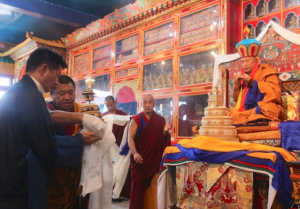
Chinese Buddhism still remains a bit of an enigma to many in the West as Zen, Tibetan and Theravadan Buddhism are very frequently highlighted most often due to the good resources available in English.
Chinese Buddhism, especially that from Mainland China, has been emerging from a period of relative inactivity almost like a butterfly emerging from gestation in its chrysalis. Many people visiting China as tourists would have come across a temple or two in their travels and even been a bit confused between Taoist and Buddhist temples or at worst a bit exasperated at the seeming commercialism of many of China’s “tourist temples”.
However, in the often-unpublished background is an emerging of a Buddhism of deep faith and action often found in small local and financially struggling monasteries. Such communities are awakening to a new dawn and trying to find their feet again but this time in a fast paced and very materialistic world. While the lure of the glamour and seeming power of the materialist environment in which these temple find themselves is powerful most are resisting the temptations and are deeply committed to strengthening the foundations upon which they were once built by offering a way of life that is in contrast to the rapidly developing world of market share and money, one which promotes peace, community and humanism so quickly eroding. Many temples are developing aged care facilities, education centres, youth services and even medical services much to the praise and support of local authorities.
Chinese Buddhism is rich in history and culture. The architecture of the temples, the vibrant art and designs, the rich musical heritage of Chinese Buddhist hymns and chants are a golden terrain for exploration and personal transformation.
Guang Jue Temple is one such small local temple situated in Zhejiang Province at a forty-five minutes drive from Hangzhou near a small rural town called Zaoxi. Its origins date back to the Qing Dynasty and was almost completely destroyed during the Sino-Japanese war. It is surrounded by a backdrop of gentle bamboo forested mountains. Often the only sounds heard are the sounds of crickets and other insects that make their homes in the trees about the temple.
Ten years ago the present abbot, Master Zheng Rong arrived with a vision and commitment to restore the temple to not only its former glory but a Buddhism of relevance to the modern society it now finds itself in. Five monks joined him in his efforts. Gradually the local community is returning. I discovered the temple by most unusual chance (that is another story for another time) two years ago. I was drawn in by its “ling” – a type of unseen force that beckons you to personal change. The Venerable Zheng Rong was eager to open the temple to Westerners. However this part of China is not on the tourist highway. It would require work. Two years later many tourists both foreign and Chinese have come to Guang Jue Monastery to partake in quiet meditation retreats, learn about the rich heritage of Chinese Buddhism and take with them the invitation to practice a way of life that promises a deeper and more lasting happiness. Gradually we have added different courses in meditation and mindfulness. Master Zheng Rong told me: “This is not a commercial enterprise. It is by donation only. Buddhism is a gift to the world. We must live the life of gift.”
Chinese Buddhism has much to give to the world. While the world focuses on the Red Dragon and the powerful economic development of China quietly and almost unseen a small most exquisitely beautiful butterfly emerges from its cocoon offering the gift of hope.
Hopefully in the future I will have the opportunity to write more for those who are interested.







All contact points I have found – web address, emails, etc – seem defunct. Can you furnish any other current information? I will be traveling in China soon and would love to visit and contribute to their work.